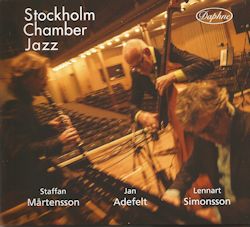1. There Will Never Be Another You
2. Sicilienne Op. 78
3. Intervention 1: Bach/Django
4. Du Gĺr Icke Ensam
5. Hommage 222
6. Stockholm Sweetnin’
7. Meditation upon La-Mi-Re
8. Nostalgia in Times Square
9. Utskärgârd
10. Intervention 2: Eccles/Things
11. Papirosn
12. Emigrantvisa
13. Västerbron
14. Visa frân Rättvik
15. Round Midnight
Staffan Mârtensson – Clarinet
Lennart Simonsson – Piano
Jan Adefelt – Bass
Attempts to fuse jazz with classical music have taken several different forms. There were Paul Whiteman’s early attempts at fusion, which led to Gershwin’s Rhapsody in Blue. There was “Jazzing the Classics”, in which bands played jazzed-up versions of such classical tunes as Liszt’s Liebestraum (by Tommy Dorsey), and a Chopin Fantasie-Impromptu as I’m Always Chasing Rainbows (by many singers, including Helen
Forrest and Dick Haymes). Then there was the “Third Stream” music, which attempted to do the same thing in a more dignified way. More recently, however,
musicians have taken to mingling the two genres in more natural ways, according to their own tastes. This last form of fusion led to the CD in hand.
Clarinettist Staffan Mârtensson started out in jazz before turning to being mainly interested in the classics. Yet his desire to convey a sense of
improvisation in all his playing drew him back towards jazz. Playing some jazz gigs, he met the two other members of this trio, and they realised that they
shared similar desires. The result is this album where (in Steffan’s words) “Classical masters meet jazz giants. Swedish folk meets Klezmer”, and there are
also original compositions and adaptations. The range is, indeed, wide: from jazz standards to Swedish folk, from baroque to the blues.
Although Staffan’s experience is in both jazz and the classics, his companions come from the jazz side of the spectrum. This does not matter particularly,
as Lennart and Jan tend to stay mostly in the background, providing supportive backing for Staffan, who takes most of the solos. These tend to step rather
warily into jazz, and Staffan seems to approach the jazz element somewhat tentatively.
There Will Never Be Another You
, for instance, has been used by jazz musicians as a suitable vehicle for swinging improvisation over many years. But Staffan’s solo seems cautious, as
though he is exploring the music rather than submerging himself completely in the improvisatory element and really “letting himself go”. Nevertheless, this
creates a charming lightness to the music, which is also present in Jan’s expert bass solo. The bass opens Charles Mingus’s Nostalgia in Times Square, which Staffan’s sleeve-notes say that they wanted to make “slow and dirty”. I wouldn’t call it “dirty” but it is
definitely bluesy.
Staffan is plagued by intonational problems on several tracks. These blemish Fauré’s Sicilienne, written originally for cello and piano. Here the
classical side dominates, with some translucent piano from Lennart Simonsson. Intervention 1: Bach/Django shows how easily a two-part invention by
Bach merges into John Lewis’s Django. The second Intervention effectively mingles part of a violin sonata by the 18th-century composer
Henri Eccles with All the Things You Are.
Some of the folk tunes are taken comparatively straight, without breaking into a jazz rhythm. In Papirosn, Staffan manages to import into his
clarinet the mournful sounds of Klezmer. Emigrantvisa includes a fine piano solo from Lennart.
Even now the concept of fusing jazz with the classics is, in many ways, novel and unsettling. As a consequence, the three performers tend to walk on
eggshells instead of letting loose with some genuine jazz swing. Though the overall effect of this session might be called “jazz lite”, the result is a
very pleasing mixture by some expert musicians who are prepared to explore uncharted waters.
Tony Augarde
www.augardebooks.co.uk
